The Effect of Plasma Activation of Reactive Gas in Reactive Magnetron Sputtering
Abstract
The effect of plasma activation of reactive gas on the process of reactive magnetron synthesis of oxide coatings was theoretically and experimentally investigated using a radio-frequency inductively coupled plasma source, which creates a flow of activated reactive gas directed towards the surface on which the oxide coating is deposited. The reactive gas passes through a dense inductively coupled plasma located inside the plasma source, while argon is supplied through a separate channel near the magnetron. A theoretical model has been built allowing the calculation of spatial distributions of fluxes of metal atoms and molecules of activated reaction gas, as well as the stoichiometry area of the synthesized coatings. Calculations were performed on the example of aluminum oxide. It was found that the plasma activation of the reactive gas allows to increase the sticking coefficient of oxygen to the surface of the growing coating from values less than 0.1 for non-activated molecular oxygen to 0.9 when 500 W of RF power is introduced into the inductive discharge. In order to verify the developed model, experiments were conducted on depositing an aluminum oxide film on glass substrates located at different distances from the magnetron target, followed by measuring the distribution of film transparency along the substrate length and comparing it with the calculated distribution. A comparison of the calculation results with the experimental data shows a good agreement in the entire studied range of parameters. Based on the generalization of the obtained results, an empirical rule was formulated that the power ratio of the magnetron discharge and the plasma activator should be approximately 8:1.
Downloads
References
L. Osterlund, I. Zoric, and B. Kasemo, Phys. Rev. B, 55, 15, 452 (1997). https://doi.org/10.1103/PhysRevB.55.15452
J. Behler, B. Delley, S. Lorenz, K. Reuter, and M. Scheffler, Phys. Rev. Lett. 94, 036104 (2005). https://doi.org/10.1103/PhysRevLett.94.036104
J.M. Schneider, and W.D. Sproul, in: Handbook of Thin Film Process Technology, edited by D.A. Glocker, and S.I. Shah, (Imprint CRC Press, Boca Raton, 1998), Ch. pA5.1, pp. 1-12.
M.K. Olsson, K. Macak, U. Helmersson, and B. Hjorvarsson, J. Vac. Sci. Technol. 16, 639 (1998). https://doi.org/10.1116/1.581081
J. Walkowicz, A. Zykov, S. Dudin, S. Yakovin, and R. Brudnias, Tribologia, 6, 163-174 (2006). https://www.tribologia.org/ptt-old/trib/Tribol_6_2006_s_163_174.pdf
R. Snyders, J.P. Dauchot, and M. Hecq, Plasma Process. Polym. 4, 113–126 (2007). https://doi.org/10.1002/ppap.200600103
S. Yakovin, S. Dudin, A. Zykov, and V. Farenik, Problems of Atomic Science and Technology, 1, 152-154 (2011). https://vant.kipt.kharkov.ua/ARTICLE/VANT_2011_1/article_2011_1_152.pdf
G. Primc, Frontiers in Physics, 10, 895264 (2022). https://doi.org/10.3389/fphy.2022.895264
J.Y. Jung, Ph.D. thesis, Optical modeling off-stoichiometric amorphous Al2O3 thin films deposited by reactive sputtering, University of Illinois, 2012. https://core.ac.uk/download/pdf/4838787.pdf
Copyright (c) 2023 Stanislav V. Dudin, Stanislav D. Yakovin, Aleksandr V. Zykov

This work is licensed under a Creative Commons Attribution 4.0 International License.
Authors who publish with this journal agree to the following terms:
- Authors retain copyright and grant the journal right of first publication with the work simultaneously licensed under a Creative Commons Attribution License that allows others to share the work with an acknowledgment of the work's authorship and initial publication in this journal.
- Authors are able to enter into separate, additional contractual arrangements for the non-exclusive distribution of the journal's published version of the work (e.g., post it to an institutional repository or publish it in a book), with an acknowledgment of its initial publication in this journal.
- Authors are permitted and encouraged to post their work online (e.g., in institutional repositories or on their website) prior to and during the submission process, as it can lead to productive exchanges, as well as earlier and greater citation of published work (See The Effect of Open Access).








